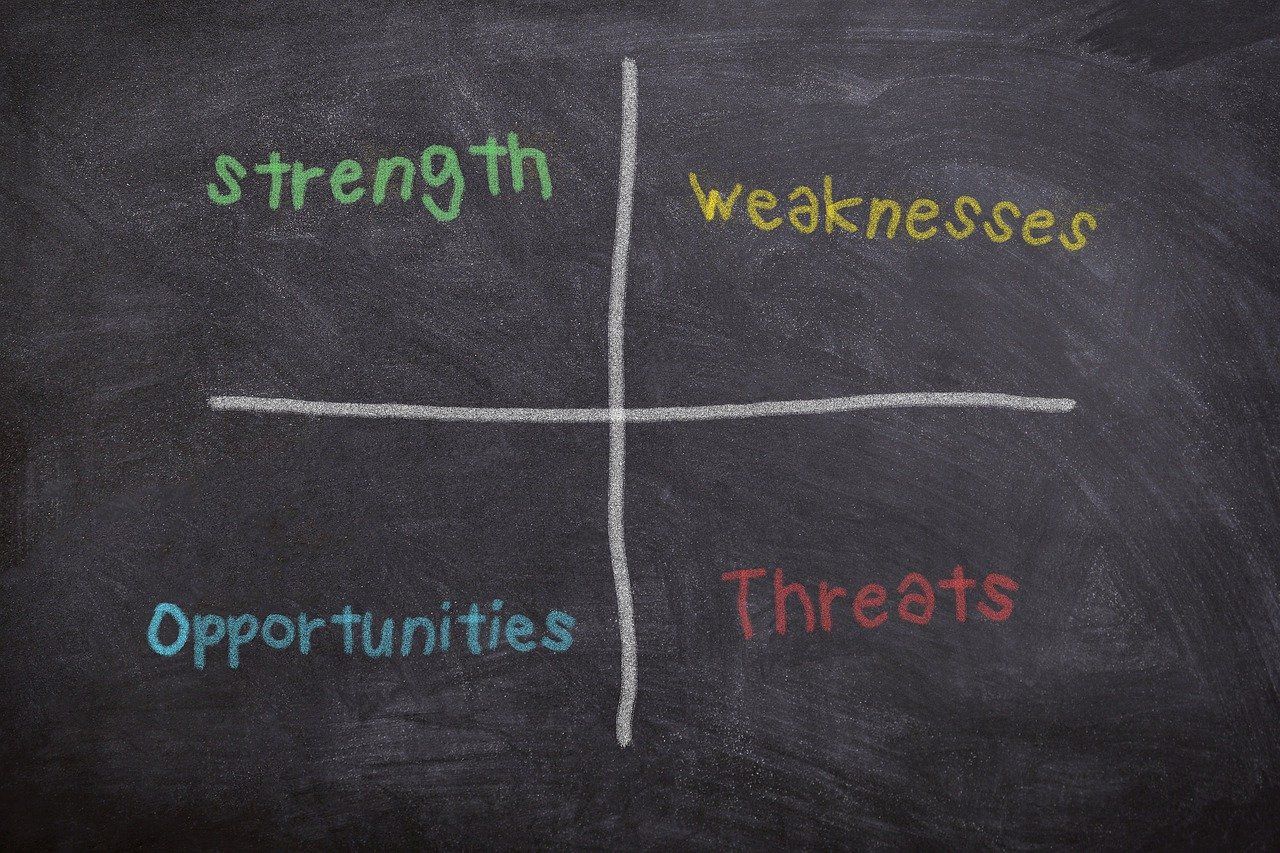Competitive strategy jest dziś tym, co przyciąga klientów do Twojej firmy. Produkty Twoje i konkurencji mogą być do siebie podobne, a usługi na tym samym poziomie. Tym, co Was różni, jest właśnie sposób, w jaki zaznaczacie swoją przewagę konkurencyjną.
What will you learn from the article?
In today's volatile and competitive business environment, having a clear competitive strategy is crucial to achieving success in the market. In this article, we will discuss various aspects of competitive strategy, starting with its definition and role in business. We will also look at the approach to competitive strategy according to two well-known authorities in the field of marketing: Michael Porter and Philip Kotler. We will also learn the concept of the mini maxi strategy and examples of its practical application.
Analiza otoczenia konkurencyjnego odgrywa kluczową rolę w procesie tworzenia skutecznej strategii konkurencyjnej, dlatego też zgłębimy jej znaczenie i metody przeprowadzania. Na koniec omówimy błędy, których warto unikać podczas opracowywania i wdrażania strategii konkurencyjnej, aby osiągnąć pożądane rezultaty. Gotowi na zgłębienie tajników efektywnego konkurowania na rynku? Zapraszamy do lektury!
Contents
- What is competitive strategy and what is its role?
- Types of business strategies - Porter's competitive advantage strategy
- Wybór strategii biznesowej – jak konkurować według Kotlera?
- What is mini maxi competitive strategy?
- Examples of competitive advantage strategies
- Competitive environment analysis - differentiated leadership strategy
- Którą strategię konkurencyjną wybrać do własnej firmy?
- Jak mierzyć skuteczność strategii konkurencji?
- Czy strategia konkurencyjna powinna się często zmieniać?
- What does the lack of a strategy lead to and what other mistakes should be avoided when building a competitive advantage?
What is competitive strategy and what is its role?
Być może od Twoich konkurentów nie odróżnia Cię zbyt wiele. A może różni was wszystko, ale klienci o tym nie wiedzą? W obu tych przypadkach potrzebna Ci jest competitive strategy, dzięki której będziesz mógł podkreślić różnice i tym samym się wyróżnić. Jeśli przyjrzysz się działalności największych firm, to szybko zauważysz, że świadomie budują one swoją przewagę w opozycji do konkurencji.
Even if both companies sell a carbonated drink that is identical in appearance and taste, they are able to find the right lure for their customers and convince them that they are dealing with two completely different products.

Choosing a competitive advantage strategy can bring many benefits to a company, such as increasing profits, increasing market share, strengthening the market position, greater customer loyalty and gaining an advantage on the market.
Małgorzata Lewandowska writes in the "International Journal of Management and Economics" that: "Developing a competition strategy means answering the questions: how the company intends to compete on the market, what its goals are and what possibilities of achieving them." The researcher notes that even the decision not to compete with market rivals is also a deliberate and planned action.
Jolanta Lubomska-Kalisz, from the Faculty of Economic Sciences and Management at the University of Szczecin, emphasizes the distinction between the strategy and competitive concept of enterprises. These are two completely different phenomena. In this classification, the first term refers to how a company competes with others. Meanwhile, the concept of competitiveness is "a general way of dealing with competition, a way of achieving and maintaining the competitiveness of an enterprise, which determines the main instruments and mechanisms of competition in the short and long term."

Types of business strategies - Porter's competitive advantage strategy
Competitive strategy (strategia konkurowania) po raz pierwszy została szerzej zdefiniowana w latach 70. Wtedy powstała teoria Michaela Portera. Według niego istnieją trzy główne sposoby na osiągnięcie odpowiedniej przewagi. Chodzi o cost leadership, differentiation and focus. The cost leadership strategy is, of course, to compete on price. Specifically, it is about minimizing overhead and direct costs.
Sources of savings can be found in areas such as advertising or research and development. They may also involve a change in strategy, e.g. focusing on the most profitable customers. On the one hand, it allows you to attract customers through lower prices. On the other hand, it somehow "impregnates" the company in case of problems. When some costs increase or the market situation changes, competitors will start to lose earlier than those who managed to optimize costs in time.
Do you want to choose the best competitive strategy and become a leader?
Our experts will prepare effective tools for you.
Druga strategia przewagi konkurencyjnej Portera to różnicowanie. Można odróżniać się od innych dzięki jakości, opakowaniom, cenie. Wyróżnik umożliwiający osiągnięcie przewagi konkurencyjnej może być faktyczny lub mieć związek ze sferą idei czy przekonań. Przeczytaj na blogu Commplace więcej o trendach w strategii różnicowania.
Porter's third competitive strategy is based on concentration. A concentration strategy involves focusing on a specific segment, area or group of customers. A specific niche strategy allows you to stand out. A company using a concentration strategy can deal with this small section in a comprehensive manner and provide, for example, the best service there.
Porter presents 3 main strategies for competitive advantage. The author uses a chart to suggest how to quickly identify the main competitive strategies and estimate which competitive strategy will be the best in a specific case. And such a broad market and cost advantage provide a cost leadership strategy. If the market is narrow and the company can compete on costs, the lowest cost strategy will be best.
A narrow market and the advantage of differentiation provide a concentration strategy, while a broad market and the advantage of differentiation indicate that it is worth choosing a differentiation strategy. In this way, in four colored fields, the author briefly presents which Porter's competitive strategy may be useful in various business realities.

Wybór strategii biznesowej – jak konkurować według Kotlera?
The second researcher who had a major impact on marketing concepts in general was Philip Kotler. We have already written about the one he developed lateral marketing. Strategia osiągania przewagi konkurencyjnej według Kotlera to drugie ważne pojęcie w jego dorobku. Wyróżnia on strategię lidera, pretendenta, naśladowcy, niszy i sojuszy. Nazwy do pewnego stopnia mówią same za siebie. Lider broni swojej pozycji na szczycie, pretendent stara się go prześcignąć, a naśladowca – dogonić tych, którzy są na czele. Competitive strategy niszy oznacza to samo, co strategia koncentracji.
Ostatnią formą konkurencji jest strategia sojuszy. Rywale wolą wtedy współpracować w określonym obszarze dla osiągnięcia wyższego celu (jakim może być zysk lub usunięcie innych konkurentów). Podsumowując: dwie najbardziej istotne w obszarze konkurencji są strategie Portera i Kotlera. W sumie dają siedem opcji, które można dopasowywać do konkretnych sytuacji i na ich podstawie oprzeć także development strategy companies.
What is mini maxi competitive strategy?
The mini maxi competitive strategy is one of the company's marketing management methods, but it will only work in some cases. Which ones? To find out, you need to take a closer look at the SWOT analysis process.
Well-planned marketing is the easiest way to achieve success in business. Well-thought-out steps always bring greater benefits than actions without any clearly defined plan. Marketing planning allows you to create a coherent strategy in pursuit of the goal. One that will allow you to maximize the company's potential and lead it to the top.
One of the basic tools for creating marketing strategies is the SWOT analysis created by Albert S. Humphrey in the 1960s. Its aim is to plan activities that will improve the company's situation on the market - it allows you to learn about the strengths (S) and weaknesses (W) of the brand, as well as opportunities (O) and threats (T). – threats) coming from the environment.
Strengths belong to internal factors. These are the elements that distinguish the company on the market and enable it to achieve success. Weaknesses, which are also considered internal factors, are the company's flaws and obstacles to success. Opportunities are external factors that can create favorable conditions for business development. Threats (external factors) are threats resulting from, for example, the activities of competitors, which may have a negative impact on the company.

Analiza SWOT to logiczne podsumowanie i uporządkowanie myśli, cech marki i postrzegania biznesu. Pełne wykorzystanie wniosków powstałych w wyniku przeprowadzenia analizy to klucz do usprawnienia działania firmy i stworzenia takiej competitive strategy, która wyróżni przedsiębiorstwo spośród innych.
Strategia konkurowania mini maxi to jeden z wyników analizy SWOT. Oznacza, że w przedsiębiorstwie słabe strony przeważają nad mocnymi, a w otoczeniu marki dominują szanse. Szanse te są jednak trudne do wykorzystania, ponieważ są ściśle związane ze słabościami marki.
Thoughtful competitive strategy mini maxi zakłada dążenie do zminimalizowania słabości, aby móc korzystać z okazji pochodzących z zewnątrz. W dużym skrócie przedsiębiorstwo wykorzystuje nadarzające się szanse przy jednoczesnej redukcji swoich słabych stron. Efektem strategii mini maxi jest znaczenie polepszenie firmy, powiększenie kapitału, co pozwala zbudować lub utrzymać przewagę konkurencyjną na rynku.
Examples of competitive advantage strategies
A well-thought-out and effectively implemented strategy is a recipe for competitive advantage on the market. W przypadku korzystania ze strategii mini maxi firma musi przezwyciężyć swoje słabe strony, żeby móc wykorzystać szanse pojawiające się na zewnątrz. Jak postępować w competitive strategy mini maxi? Działania można podzielić na kilka etapów:
- increasing your resources,
- improvement of the offered products,
- increasing productivity,
- reducing the cost,
- striving to maintain a competitive advantage.
At the beginning, it is worth conducting a detailed analysis of the company's resources - financial, product. It may turn out that the company's resources are insufficient. It is therefore important to find a way to increase them by taking advantage of the opportunities that arise. An example of such an action may be the conclusion of a cooperation agreement with another company. Collaboration will not only increase resources, but can also eliminate a competitive threat (the partner could become a brand competitor in the future).
Podniesienie wydajności, udoskonalenie produktu i próba zmniejszenia kosztów to kolejne ważne kroki w competitive strategy mini maxi. Najpierw należy skupić się na produkcie. Czy czegoś mu brakuje? Jakich kanałów dystrybucji używamy? Jak skutecznie sprzedawać produkt? Ważna jest również analiza produktywności. Może okazać się, że przy posiadanych zasobach, jesteśmy w stanie wyprodukować więcej produktu. Warto pomyśleć również o redukcji kosztów, która da nam poczucie komfortu. Aby utrzymać przewagę konkurencyjną, trzeba stale monitorować rynek i wykorzystywać wszystkie nadarzające się okazje. Przykładem może być powiększenie asortymentu, a nie kurczowe trzymanie się jednego produktu.
W prowadzeniu competitive strategy kluczowe jest strategic management - that is, the constant search for a way for the company to adapt to changing external and internal conditions. Strategic management is a constant modification of goals and methods of achieving the goal, which allows you to effectively manage resources, achieve the best financial results and maintain a competitive advantage on the market.
Do you want to leave the competition behind?
Check how to do it!
Competitive environment analysis - differentiated leadership strategy
Zanim jednak zdecydujesz się na wdrożenie jednej ze strategii konkurencyjnych, musisz poznać otoczenia, w którym funkcjonuje Twoja firma. Znajomość rynku i przemyślana competitive strategy to klucz do sukcesu.
The most important element of the competitive environment are companies from the same industry - brands that offer products or services similar to yours and have the same target group. The more competitors there are, the harder it is to become a market leader. However, you should remember that not every company from the same industry poses a real threat to us. Therefore, market research should be reliable. It must take into account various elements and variables - including entry and exit barriers.
Entry and exit barriers are also important to the development of potential competitors. Entry barriers are factors that make it more difficult for firms to enter a given market, and exits reduce the attractiveness of new businesses. The lower the barriers to entry and the greater the exit, the more likely the market is to develop new competition. When analyzing the company's environment, take into account the substitutes of your products / services. Also consider whether there may be new substitutes that will be more attractive to customers in the near future.
Another important issue is the number and quality of suppliers. The worst situation is the availability of only one supplier who, due to the monopoly, will not pay attention to the quality of service, and at the same time will dictate high prices. It is better when there are several suppliers on the market that have to compete with each other and, consequently, offer good quality and favorable prices.
Którą strategię konkurencyjną wybrać do własnej firmy?
Wybór odpowiedniej competitive strategy jest kluczowy dla sukcesu przedsiębiorstwa na rynku. Istnieje kilka podejść, takich jak strategia koncentracji, strategia przywództwa kosztowego czy strategia różnicowania. Strategia koncentracji polega na skupieniu się na konkretnym segmencie rynku, dostosowując ofertę do jego unikalnych potrzeb. Z kolei strategia konkurencji oparta na różnicowaniu zakłada wyróżnienie produktów lub usług poprzez unikatowe cechy, które są cenione przez klientów. Natomiast strategia przywództwa kosztowego dąży do osiągnięcia przewagi poprzez minimalizację kosztów i oferowanie niższych cen. Decyzja o wyborze konkretnej competitive strategy powinna być poprzedzona dogłębną analizą rynku, zasobów firmy oraz oczekiwań klientów.
Jak mierzyć skuteczność strategii konkurencji?
Ocena efektywności wdrożonej strategii konkurencji wymaga zastosowania odpowiednich wskaźników. Kluczowe metryki to m.in. wzrost udziału w rynku, poziom satysfakcji klientów czy rentowność sprzedaży. Analizując te dane, przedsiębiorstwo może ocenić, czy przyjęta competitive strategy przynosi oczekiwane rezultaty. Regularne monitorowanie tych wskaźników pozwala na szybką reakcję w przypadku odchyleń od założonych celów. Warto również porównać wyniki z konkurencją, aby zrozumieć swoją pozycję w branży. Taka analiza dostarcza cennych informacji na temat skuteczności realizowanej strategii konkurencji.
Czy strategia konkurencyjna powinna się często zmieniać?
W dynamicznie zmieniającym się otoczeniu biznesowym elastyczność jest niezbędna. Jednak zbyt częste modyfikacje competitive strategy mogą wprowadzać chaos i dezorientację wśród pracowników oraz klientów. Zamiast tego, warto regularnie analizować efektywność obecnej strategii konkurencji i dostosowywać ją w odpowiedzi na istotne zmiany rynkowe. Stałe monitorowanie trendów, działań konkurencji oraz potrzeb klientów pozwala na świadome i przemyślane aktualizacje competitive strategy. Dzięki temu firma może utrzymać swoją pozycję na rynku, jednocześnie unikając destabilizacji wynikającej z nadmiernych zmian.
Otoczenie przedsiębiorstwa to również klienci. Żeby ustalić skuteczną competitive strategy, trzeba poznać profil konsumenta, jego potrzeby, oczekiwania. Aby przyciągnąć uwagę odbiorców i utrzymać dobre relacje z nimi, trzeba zadbać o atrakcyjność przekazu, innowacyjność i oryginalność produktu oraz dobry model obsługi posprzedażowej.

The last, but no less important, element is consumer trends. It is awareness of what is happening around you. The analysis of trends allows you to introduce changes, apply innovative ideas, create an offer that best suits the needs of customers and the current realities, and thus stand out from the competition.
What does the lack of a strategy lead to and what other mistakes should be avoided when building a competitive advantage?
It may seem that highlighting a competitor's downsides is the best option to beat the competition. Meanwhile, numerous studies prove that communication strategy based on a negative message is not effective. If you highlight your competitors' flaws on your website or in your ads, customers will not remember the details, but only a negative impression.
Podobnie jest, gdy zbyt mocno skupiasz się na problemie, zamiast na rozwiązaniu, które oferujesz. Competitive strategy może być ofensywna lub defensywna. Na ofensywną decydują się często firmy o dużych zasobach. To mogą być prowadzone z zewnątrz PR campaigns hitting a competitor, but even then, the brand in the advertising message does not focus on the competition's disadvantages and problems, but on its own benefits and solutions.
Chcesz dowiedzieć się, czym w praktyce różnią się główne competitive strategies? Chcesz wyprzedzić konkurencję i zwiększyć sprzedaż? contact us and start achieving these goals even more effectively.

